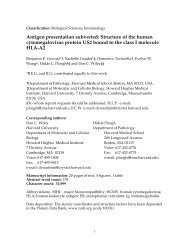X-ray structure of a protein-conducting channel - The Laboratory of ...
X-ray structure of a protein-conducting channel - The Laboratory of ...
X-ray structure of a protein-conducting channel - The Laboratory of ...
Create successful ePaper yourself
Turn your PDF publications into a flip-book with our unique Google optimized e-Paper software.
articlesflattening and histogram matching. After obtaining an initialmodel, we generated point mutants in the a-subunit aimed atstrengthening crystal contacts. One double mutant (Lys422Arg andVal423Thr), called Y1, gave crystals that diffracted to 3.2 Å. <strong>The</strong>reare subtle differences between the mutant and wild-type <strong>structure</strong>s(see Supplementary Fig. S2), and we have used the latter to generatethe figures below. <strong>The</strong> final wild-type model includes all residues,with the exception <strong>of</strong> some at the termini (a-subunit 434–436;b-subunit 1–20, 53; g-subunit 67–73). Examples <strong>of</strong> the fit into theexperimental electron density map are shown in Supplementary Fig.S3, and a summary <strong>of</strong> the quality <strong>of</strong> the <strong>structure</strong>s is given in Table 1.Architecture <strong>of</strong> the SecY complexGeneral characteristics<strong>The</strong> crystal <strong>structure</strong> contains a single copy <strong>of</strong> the SecY complexwith one polypeptide chain <strong>of</strong> each <strong>of</strong> the three subunits. Figure 1ashows a stereo view from the cytoplasm (‘top view’) and Fig. 1bshows the complex from the side (for more details, see SupplementaryFig. S4). As expected (see ref. 4), the a-subunit contains tenTMs with amino and carboxy termini in the cytosol, and the b- andg-subunits have one TM each, with their N termini in the cytosol.Viewed from the top, the SecY complex has an approximatelyrectangular shape (Fig. 1a). <strong>The</strong> a-subunit is open on one side(the ‘front’) and is surrounded on the remaining three sides by thetwo smaller subunits. <strong>The</strong> side view shows that only the cytoplasmicdomains protrude significantly beyond the phospholipid-headgroupregion <strong>of</strong> the membrane (Fig. 1b).<strong>The</strong> a-subunitThis subunit is divided into two halves, TM1–5 and TM6–10(Fig. 1c), which are connected at the back <strong>of</strong> the molecule by anexternal loop between TM5 and TM6. Each half consists <strong>of</strong> threeouter and two inner TMs (Fig. 1d) related by pseudo-symmetrythrough a two-fold rotation axis in the plane <strong>of</strong> the membrane(Fig. 1d), and they have similar folds (Supplementary Fig. S5). <strong>The</strong>second half is essentially an inverted version <strong>of</strong> the first half, andpairs <strong>of</strong> helices in the two parts are topologically related (forexample, TM2 and TM7). A similar pseudo-symmetry that is notobvious from the primary sequence has also been observed in the<strong>structure</strong>s <strong>of</strong> several other membrane <strong>protein</strong>s (for example, refs20, 21).Many <strong>of</strong> the TMs in the a-subunit are not perpendicular to theplane <strong>of</strong> the membrane (for example, TM2, TM5 and TM7), andTable 1 Crystallographic statisticsData set SeMet (X25)* Y1 mutant (8BM)*.............................................................................................................................................................................Resolution (Å) 3.5 3.2Unique reflections 14,439 (1,291) 18,118 (1,439)I/Ij 30.9 (2.74) 26.9 (2.24)Completeness (%) 98.4 (89.6) 93.2 (76.1)R sym † 0.08 (0.67) 0.05 (0.44)Phasing to 3.8 ÅFOM (from SOLVE) 0.29 (0.19)Map correlation‡ 0.24Mean phase difference (8)§ 75.1 (77.6)R cryst k 0.254 (0.383) 0.242 (0.414)R free { 0.334 (0.463) 0.287 (0.442)r.m.s. deviation bond length (Å) 0.008 0.008r.m.s. deviation bond angles (8) 1.3 1.23Mean B-factor 122.4 97.8.............................................................................................................................................................................*Values in parentheses refer to data in the highest-resolution shell (3.63 Å to 3.50 Å and 3.31 Å to3.20 Å in the wild-type and mutant data sets, respectively). SeMet, selenomethionine.†R sym ¼ S hklS ijI iðhklÞ 2 IðhklÞj=S hklS ijI iðhklÞj; where I(hkl) is the average intensity. All reflectionswere used.‡<strong>The</strong> map correlation coefficient is the correlation between a synthetic electron density mapcalculated on the basis <strong>of</strong> the final model and the map corresponding to the experimental set <strong>of</strong>phases, averaged over all grid points.§Mean phase difference between initial phases from SOLVE and phases calculated from the finalrefined wild-type model. <strong>The</strong> phase difference is defined as the average difference betweenexperimental phases and phases calculated from the final refined model.kR cryst ¼ S hklkF obsj 2 kjF calck=S hkljF obsj{R free is the same as R cryst for a selected subset (10%) <strong>of</strong> the reflections that was not included inprior refinement calculations.some do not span the entire membrane (for example, TM9 andTM10). In addition, several loops have a complex secondary<strong>structure</strong>, and some are tucked back into the membrane (forexample, the loop between TM7 and TM8). <strong>The</strong> most strikingfeature <strong>of</strong> the a-subunit is the segment following TM1 (Fig. 1e). Inmost organisms, it begins with the sequence PFXG (F is a conservedhydrophobic amino acid). It then continues as a long loop that runsalong the external side <strong>of</strong> the molecule before leading back into thecentre <strong>of</strong> the a-subunit and ending in a short, distorted helix, calledTM2a. This helix extends to a point about halfway through themembrane (Fig. 1e). It is not particularly hydrophobic and waspredicted to be in the external aqueous phase 22 . TM2a is followedby a segment resembling a b-hairpin loop centred on Gly 68(Supplementary Fig. S3a). This loop ends in the middle <strong>of</strong> themembrane at the completely conserved Gly 74 <strong>of</strong> the sequenceGFXP. A sharp turn leads into TM2b, which extends from the centre<strong>of</strong> the molecule outwards at a ,308 angle with respect to the plane <strong>of</strong>the membrane.<strong>The</strong> b-subunitThis polypeptide begins with a disordered cytoplasmic segmentfollowed by a loop that crosses over the N terminus <strong>of</strong> the a-subunit(Fig. 1a). <strong>The</strong> TM is almost perpendicular to the plane <strong>of</strong> themembrane and comes close to the C terminus <strong>of</strong> the g-subunit atthe external side <strong>of</strong> the membrane (Fig. 1b). <strong>The</strong> b-subunit makesonly limited contact with the a-subunit, which may explain why it isnot essential for the function <strong>of</strong> the complex.<strong>The</strong> g-subunitThis subunit consists <strong>of</strong> two helices. <strong>The</strong> N-terminal helix lies on thecytoplasmic surface <strong>of</strong> the membrane (Fig. 1a, b). In agreement withpredictions and crosslinking studies 23,24 , this helix is amphipathicwith the hydrophobic surface pointing towards the membrane,contacting the C-terminal part <strong>of</strong> the a-subunit. <strong>The</strong> helix isfollowed by a short b-strand that forms a sheet with a segment <strong>of</strong>the b-hairpin between TM6 and TM7 <strong>of</strong> the a-subunit (Fig. 1a).<strong>The</strong> TM <strong>of</strong> the g-subunit is a long, curved helix that crosses themembrane at a ,358 angle with respect to the plane <strong>of</strong> themembrane (Fig. 1b). One side <strong>of</strong> the helix makes limited contactswith TM1, TM5, TM6 and TM10 <strong>of</strong> the a-subunit, and thus clampstogether the two halves <strong>of</strong> the a-subunit.Comparison with the EM <strong>structure</strong> <strong>of</strong> the E. coli SecY complexFunctional interpretations <strong>of</strong> the X-<strong>ray</strong> <strong>structure</strong> must be based onthe large body <strong>of</strong> experimental work carried out on systems fromE. coli, mammals and S. cerevisiae; no functional data are availablefor archaeal SecY complexes, but the X-<strong>ray</strong> <strong>structure</strong> <strong>of</strong> theM. jannaschii complex is probably representative <strong>of</strong> all species.<strong>The</strong> amino-acid sequences <strong>of</strong> the M. jannaschii subunits are quitesimilar to those in eukaryotes and eubacteria (,50% similarity)(Supplementary Fig. S1). Fitting the X-<strong>ray</strong> <strong>structure</strong> into theelectron density map <strong>of</strong> the 2D crystal <strong>structure</strong> <strong>of</strong> the E. coli SecYcomplex, determined by EM 19 , shows that the TM segments <strong>of</strong> theSecY complexes from M. jannaschii and E. coli are arranged innearly identical ways (Fig. 2a). We can identify all TMs in the E. colia-subunit and observe that many features are conserved, includingthe position <strong>of</strong> the unusual segment following TM1 (Fig. 2a). <strong>The</strong>external loops between TM7 and TM8 and between TM5 and TM6are shorter in eubacteria, causing small shifts in some helices, butthe changes are confined largely to lipid-facing parts <strong>of</strong> the molecule,which have few conserved residues (Supplementary Fig. S6).<strong>The</strong> agreement between the X-<strong>ray</strong> and EM models also shows thatthe architecture is the same whether in detergent solution or in aphospholipid bilayer. Moreover, as the a-subunit in the 2D crystal ispart <strong>of</strong> a dimer 19 (Fig. 2a, b), oligomerization does not grosslychange the conformation <strong>of</strong> the SecY complex.<strong>The</strong> small subunits <strong>of</strong> the E. coli complex in the EM <strong>structure</strong> canNATURE | VOL 427 | 1 JANUARY 2004 | www.nature.com/nature 37© 2003 Nature Publishing Group






